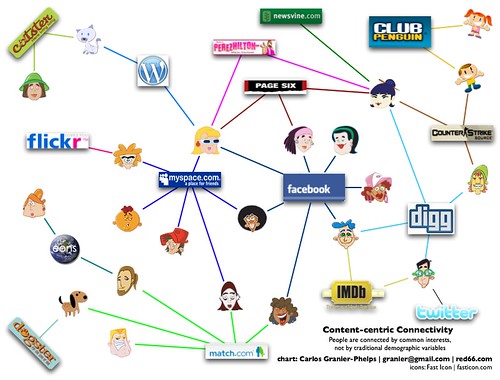Bernard Lunn, at Read/WriteWeb wrote an interesting article about the failure of Eons.
Eons is a social networking website aimed at the over-fifty crowd, headed by the founder of job-site Monster.com. After raising $32M, Eons is now [cutting it’s workforce in half](http://www.xconomy.com/2007/09/12/eons-announces-big-layoffs-as-company-refocuses-on-social-networking-it-was-kind-of-like-survivor/ “Eons Announces Big Layoffs as Company Refocuses on Social Networking: “It Was Kind of Like Survivor."") - not exactly a measure of success.
In his article, Lunn touches a point I’ve been making for a long time: people gather around content, not around demographic variables (see “The Advertiser’s Dilemma”, “Rethinking Ratings” and “Why Google Should Buy YouTube” for my previous articles on content-centric ratings analysis).
Lunn think the problem lies in Eons’ strategy to connect people around age, a traditional demographic variable, and not around content or common interests. He’s hit the nail squarely on the head:
“…people want to connect around content, not around age. Connecting around content is what Blogs do. You connect on something that interests you. (…) As you get older, you get a more varied set of interests and human relationships across all ages.”
Age/Sex/Location is not a social network
Demographic variables allow advertisers and their clients to easily target their products to artificial segments of the population that probably have very little else in common, other than age/sex/location. In a small-town-world these variables may have been good enough to create desirable advertising targets, but we now live in a connected world where people of all ages and genders interact and share common interests on a scale seldom seen before.
And while you can still use demographic variables to target your product, you’d be missing a much more interesting target, one capable of creating die-hard fans and viral awareness of your product, by ignoring content-centric connections.
As for social networks, look at the successful ones and the “glue” that keeps them together:
- facebook: college students (now everyone)
- imdb: movies
- dogster/catster: pets
- flickr: photos
- digg: tech news
- youtube: videos
Building a social network around content will not magically make it successful, just like putting wings on a box won’t make it fly; but those wings sure help once you put the rest of the airplane together.
The Content-centric Connectivity Chart
The following chart is an example of how people of different ages, genders and cultural backgrounds gather around common interests (caveat: networks are not drawn to scale, connections do not attempt to imply actual traffic for these sites, and age/gender/race were limited by the avatar icons I could find on the net).
The Content-centric Connectivity chart highlights two key ideas:
- Successful networks are built around content, not around demographics.
- There’s a huge opportunity for anyone who learns how to target their products around content-centric communities.
Conclusion
There will always be products that need to be targeted around demographic variables (e.g., feminine products, some toys, acne-medication, denture products), but the opportunities and tools for expanding your product’s appeal have never been this good.
Let's Connect
If you want to hire me or get in touch about something or just to say hi, reach out on social media or send me an email.
Other blogs
Some other blogs where I've posted throughout the years. Most of these will eventually migrate here.
